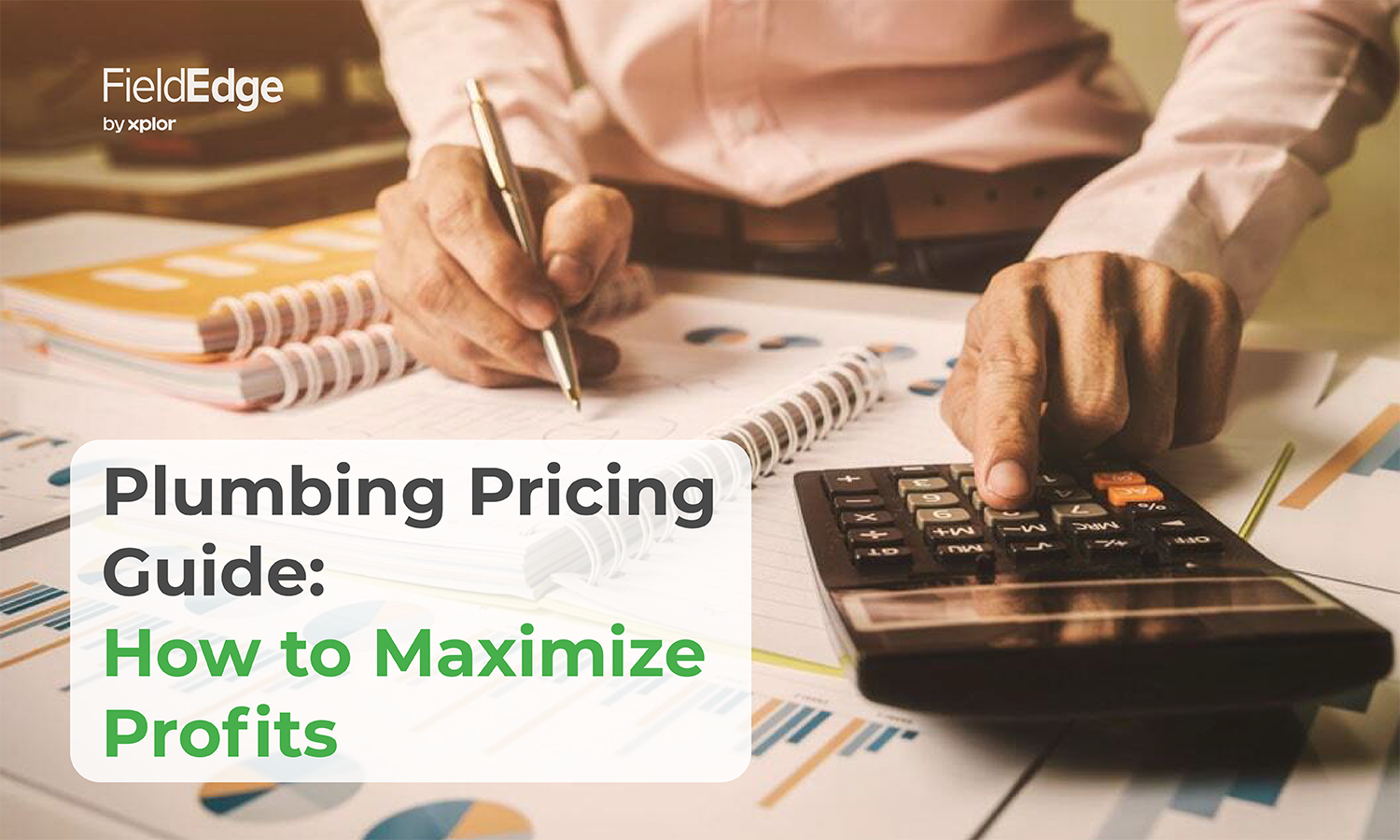One of the biggest challenges in owning a plumbing business is knowing how to properly price your services. Use this ultimate plumbing pricing manual to get your prices right the first time and maximize profits.
Even though plumbing pricing might seem impossibly complicated, when you have the right tools and processes in place, you can set the right prices with ease. In this complete plumbing pricing guide, you’ll get everything you need to maximize your profits using:
- Profit goals
- Customer feedback
- Your break-even point
- A financial advisor’s advice
- Insight from your target market
- The right pricing model for your business
When you take advantage of this plumbing pricing manual, you’ll have the power to properly price services for maximum profit and with minimal stress.
1. Leverage Insight from Your Local Target Market
It’s important to leverage insight from your local target market to sell more effectively to ideal customers.
Start by identifying your ideal (or favorite) customer to answer questions such as:
- What’s their age range?
- Are they married or single?
- What’s their education level?
- What’s their household income?
- Do they have kids? If so, how many?
- What are some of their challenges or pain points?
- What do they do for a living? Do they have any spare time?
Keep in mind, it’s important to be as detailed as possible in answering these questions. After all, the more you know about your ideal customer, the better you can sell to them.
Now, define what your ideal customers want. Do this by sending a survey to your best customers with questions like:
- What about our plumbing business do you love the most?
- Why did you choose our plumbing business over our competitors?
- What do you care about most when choosing a plumbing service provider?
After discovering what your ideal customers want, use this information to find local trends, and also see which services are the most common. For example, are there any recurring maintenance services or packages that sell better?
Also, when are your busy and slow seasons? Identify which times of year are best to sell plumbing services so you know which plumbing services sell best during different times of the year. Take advantage of these insights so you’ll be able to increase conversions and stand out from competitors.
Now, you’re able to use the insights you’ve gathered from your local target market to improve marketing strategies and increase your conversions with:
- Flyers
- Social media
- Facebook Ads
- Business cards
2. Calculate Your Break-Even Point
Find the minimum you need to charge to step onto a property by calculating your break-even point.
First, add all of your monthly overhead costs:
- Utilities
- Plumbing Software/IT
- Vehicle payments
- Vehicle insurance
- Business insurance
- Property rental costs
- Office staff/leadership pay
- Vehicle/equipment maintenance
After you’ve added up ALL of the monthly overhead costs you have for completing jobs, you’ll have your total business monthly overhead expenses.
Then, you need to calculate your total estimated labor costs by multiplying these numbers:
- Number of techs on the team
- Average hourly pay
- Hours worked
Next, it’s time to calculate your total monthly revenue required (the break-even point) by adding up the previous calculations:
Total Monthly Business Overhead Expenses + Total Estimated Labor Costs = Total Monthly Revenue Required
After adding up all costs, you know your break-even point and the minimum you need to charge so you won’t lose money on projects.
Don’t forget to inform your trusted financial advisor or accountant of your estimated break-even point.
3. Choose the Right Plumbing Pricing Model
Now that you know your break-even point, you need to know which plumbing pricing model to use: time and materials or flat rate pricing. Keep in mind, your pricing model might be a factor in your profit goals, calculating cost, and more.
Time and Materials Pricing
In short, time and materials pricing is when you bill a customer for the technician’s time, plus any additional costs incurred from the project after it’s complete. However, this pricing model might be a harder sell for some customers (especially first-timers).
Since it helps to ensure your jobs are profitable, some plumbing businesses choose to bill customers for projects using time and materials pricing. We will give more guidance on calculating time and materials costs later on.
Pros of Time and Materials Pricing
- Take more control over revenue by setting the profit margin for each project. Since you can calculate the cost after the project’s completion, there’s no need to know the exact average time and materials beforehand.
Cons of Time and Materials Pricing
- Since they prefer to know the upfront costs, it can be a harder sell to customers.
- It’s time consuming because you have to add up your plumber’s time and materials for every project in order to create a new estimate.
Flat Rate Pricing
Flat rate pricing is when you combine your technician’s hourly rate with the cost of parts needed to bill customers for service calls and trip fees. Customers often prefer flat rate pricing since you present it on-site.
Whereas, time and materials pricing is used to bill for projects because these costs are oftentimes unpredictable.
Even though you need accurate average times and cost of materials to find your perfect flat rate price, a powerful plumbing software (like FieldEdge) can track these numbers for you.
Pros of Flat Rate Pricing
- Since surprise fees don’t spring up, your customers are more comfortable.
- You don’t need to create new estimates from scratch – just refer to your flat rate pricing database tool or book.
Cons of Flat Rate Pricing
- A flat rate book or tool is a must because you need to know PRECISE costs of materials per job.
- Rather than basing fees on each plumber’s time on the project, your plumber will have a set amount of time to complete their job.
How to Use Flat Rate Pricing
Flat rate pricing should be standardized and all of your technicians should be able to complete their jobs within a set timeframe using set tools and equipment. Remember that flat rate pricing varies from service to service – not technician to technician. In turn, you won’t charge by the hour after the fact.
Even though flat rate pricing may appear to be a bit daunting, it doesn’t have to be. When you know your numbers and have set systems in place for equipment and task pricing, you’ll have the ability to ensure every job is profitable – all without spending additional time on estimates.
Don’t forget to take into consideration the wide variety of equipment costs as you’re setting up your flat rate pricing tool or book. Remember, the more precise your flat rate pricing, the easier it will be to reach profit goals.
Service Calls and Trip Fees
Sometimes, plumbing businesses charge a minimum two-hour service fee in addition to a flat trip fee. However, if the work exceeds the two hour time window, then you’ll have the ability to switch to flat rate pricing if you choose.
In this case, you’d only charge for the labor of the specific tasks you’ve completed. Depending on the project, you might either offer a discount or waive the two-hour service call fee altogether.
Usually, your trip fee is a set price. However, don’t forget to take your local traffic into consideration.
For instance, if you’re servicing someone in a low traffic area, then you might set a lower trip fee and vice versa. Though, don’t forget about rural areas with no traffic either, since there will be more drive time you need to take into consideration.
We recommend lowering your service call fee and raising labor rates in flat rate pricing to attract more first-time customers. As a result, you’ll not only attract more first-time customers, but you’ll also maintain the same profit in your flat rate pricing model.
Did you know the #1 plumbing software has the power to automatically and accurately track time and materials? Book a FREE demo to experience what FieldEdge can do for your plumbing business!
4. Determine Your Project Costs
Once you know your pricing model, you need to determine on-site costs so you know how much to charge for specific projects.
First, calculate your total project material expenses by adding up these numbers:
- Total cost of parts/equipment per job (FieldEdge can help with this!)
- Total cost of chemicals per job
- Disposal costs
Be sure to add up ALL of your specific project costs. Then, calculate your total project materials cost by inputting the previous calculation into this formula:
Total Project Material Expenses + (Total Project Material Expenses x Profit Margin) = Total Project Materials Cost
Next, multiply these numbers to find your total labor costs:
- Hourly rate
- Estimated number of hours
Then, calculate total project labor costs by inputting the previous calculation into this formula:
Total Project Material Cost + Total Project Labor Cost = Total Project Cost
5. Set the Right Profit Goals for Your Plumbing Business
Since you’ve determined project costs, it’s time to set the right profit goals so you can incorporate them into your plumbing pricing.
Step 1: Calculate Your Net Income
Set achievable profit goals by calculating net income using this formula:
Net Income = Total Revenue – Material Costs – Labor Costs – Overhead Costs
Then, using the net income you just calculated, find profit margin using this formula:
Profit Margin = Net Income / Total Revenue
Step 2: Incorporate Your Profit Margin Goals into the Total Price of the Plumbing Service
It’s important to test out a few different profit margin goals to find out what’s best for your plumbing business. Remember, sales goals will increase with their profit margin goals. Also, don’t forget that your goals need to be achievable, yet ambitious.
Step 3: Compare Plumbing Pricing to Your Competition to Stay Reasonable
By comparing your plumbing pricing to local competition, you can ensure you’re staying within a reasonable pricing range – not too low or too high.
However, you can’t copy competitors because their costs and goals are different. Though, comparing these prices gives you a general idea of whether or not you’re reasonably priced.
Be sure to incorporate your goals into plumbing pricing before comparing your prices to the competition.
6. Consult With a Trusted Financial Advisor or Accountant to Verify Your New Plumbing Pricing
Before you finalize it, consult with a trusted financial advisor or accountant to verify your new plumbing pricing.
This is an absolutely essential aspect of the plumbing pricing process. Your financial advisor can tell if there are any factors you forgot to consider as well as how much you need to charge.
Remember, finances are the lifeblood of your plumbing business – you can’t afford to skip this step!
By the way, did you know that you can use FieldEdge (the best plumbing software) to track all of these costs (and more)? Book a FREE demo to discover how FieldEdge will transform your plumbing business.
7. Use a Plumbing Flat Rate Book
When you follow the flat rate pricing model, use a plumbing price book to provide potential customers with detailed explanations of your services and plumbing pricing.
It’s important to take advantage of a book or digital tool to assist customers in understanding costs. Plus, it keeps you from answering the same plumbing pricing questions on a daily basis. Your plumbing flat rate book or tool should contain items such as:
- Your business name and contact information
- Disclaimer that ALL estimates are subject to change
- Breakdown of costs for each task and piece of equipment
FieldEdge also helps you with an in-the-field pricebook and invoicing. Instead of using a physical pricebook, you can go paperless with FieldEdge Flat Rate Mobile. Book a FREE demo of FieldEdge now!
8. Use Customer Feedback to Improve Your Plumbing Pricing Process
It’s important to use customer feedback to improve the plumbing pricing process. Gather feedback by doing things like:
- Conduct social media polls
- Call or ask for feedback in-person (after a positive customer experience)
- Text surveys and follow-up texts (easily automate texts using FieldEdge)
- Encourage reviews (keep in mind, you should not incentivize reviews)
- Email surveys and follow-up emails
Raise plumbing pricing on a few unprofitable customers first, then send them a survey to find out if they’re still happy with your plumbing business. Then, use this customer feedback to improve your plumbing pricing process for more profitable customers.
Use This Complete Plumbing Pricing Guide to Maximize Your Profits TODAY
When you take advantage of this simple, complete plumbing pricing guide, you’ll have the power to maximize profits and conquer your goals starting TODAY.
Use this guide to ensure you’re considering the right factors and implementing the proper plumbing pricing process.
These top pricing strategies will help your plumbing business find long-lasting success!
Related: Increase Plumbing Sales in 9 Steps




